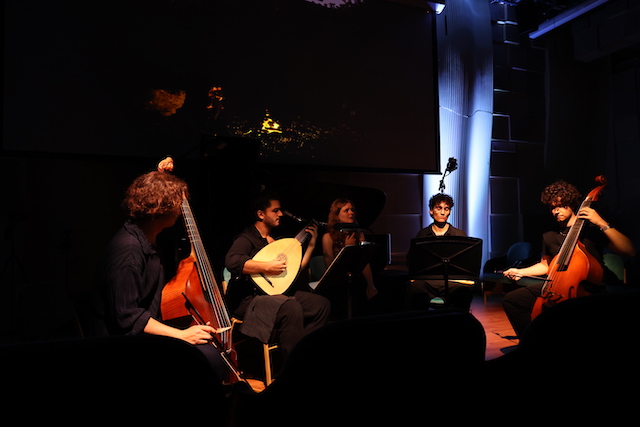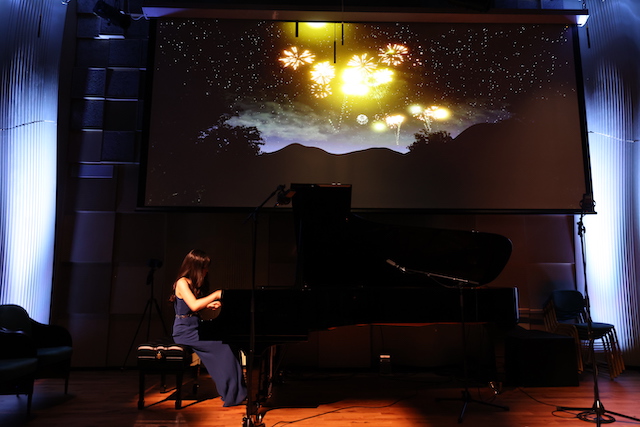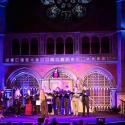To mark this year’s summer solstice, a small audience gathered at London’s newest concert venue, the World Heart Beat Embassy Gardens, a small and perfectly formed hall bristling with “state-of-the-art” acoustics and digital facilities. On a balmy midsummer’s evening, the pianist and composer Rieko Makita invited us to reflect on the different moods and aspects of the night, in a programme that combined music with digital art projections.
Makita is part of the ever-expanding movement in London to explore technology and new venues as a way of taking classical music to different audiences. For this concert – in which she teamed up with the bracingly edgy Londinium Consort (pictured below) – she deployed music ranging from easy crowd-pleasers, like Debussy’s Clair de Lune, to more experimental new compositions as she investigated both the reflective and ebullient sides of life after sunset.
The evening opened with Makita’s own composition, As the sun sets, a meditative piece to mellow the senses as – on a screen above the piano – we contemplated a blood-red sun reflected in water. Then the screen went dark and the aching melodies of African American composer Florence Price’s Night filled the room, stylishly performed by American soprano Anne Sutton and accompanied by Makita.
After this nocturnal amuse bouche, Makita explained to the audience that the first part of the evening was going to be devoted to looking at the more introspective nature of the night. She began with Robert Schumann’s Des Abends from Fantasiestücke, Op 12, the lyrically beautiful, intimate work in D flat major that he wrote in the same year he became engaged to Clara. On the screen, a candlelit bedroom appeared before us with the curtains open to display the moon in the night sky. The projection was tasteful, yet it couldn’t catch the opalescent subtlety of Makita’s performance, in which the cross-rhythms created a gentle sense of fluidity as the melody rang out like a bell.
Such concerns aside, Makita’s overall concept was an engaging one and there were many diverting aspects to the evening. Her performance of Liszt’s Liebestraum No. 3 alternated velvety harmonies with shimmering clouds of notes as the digital projection swirled us into outer space. A glittering execution of Debussy’s Feux d’artifice demonstrated once more that the vibrant colours she generated as a pianist could not be matched by the digital fireworks on screen.
This first part of the evening also featured guest appearances from different members of the young and rising early music ensemble, Londinium Consort. A highlight was Ozgur Kaya’s performance of Lili Boulanger’s Nocturne on the cello, which captured the wildness of her vision at the same time as mining the exquisite lyricism at the piece’s core. For the second part of the evening, Communal Night, the group took command of the programme, interspersing works by the king of melancholy, Renaissance composer John Dowland, with a song by Monteverdi and a composition by Kaya inspired by Gerard Manley Hopkins. The Monteverdi Ohimè, ch’io cado was delivered with enjoyable anarchic vigour by Sutton with an accompaniment from the rest of the ensemble that felt almost jazz-like, while Kaya’s spelt from sibyl’s leaves augmented its sinuous melody with beguilingly sinister rattles and otherworldly clatters.
Makita is to be commended for this experiment, which contained many enticing elements. What she needs now is the courage to push both herself and her visual collaborators further. There is huge potential in this kind of musical/visual cross-fertilisation – my personal favourite from last year was the City of London Sinfonia’s From Pole to Pole, in which climate scientist Simon Clark fascinatingly matched music to different kinds of cloud. This is a good initial step, and it will be intriguing to see what inspires her next.












Add comment